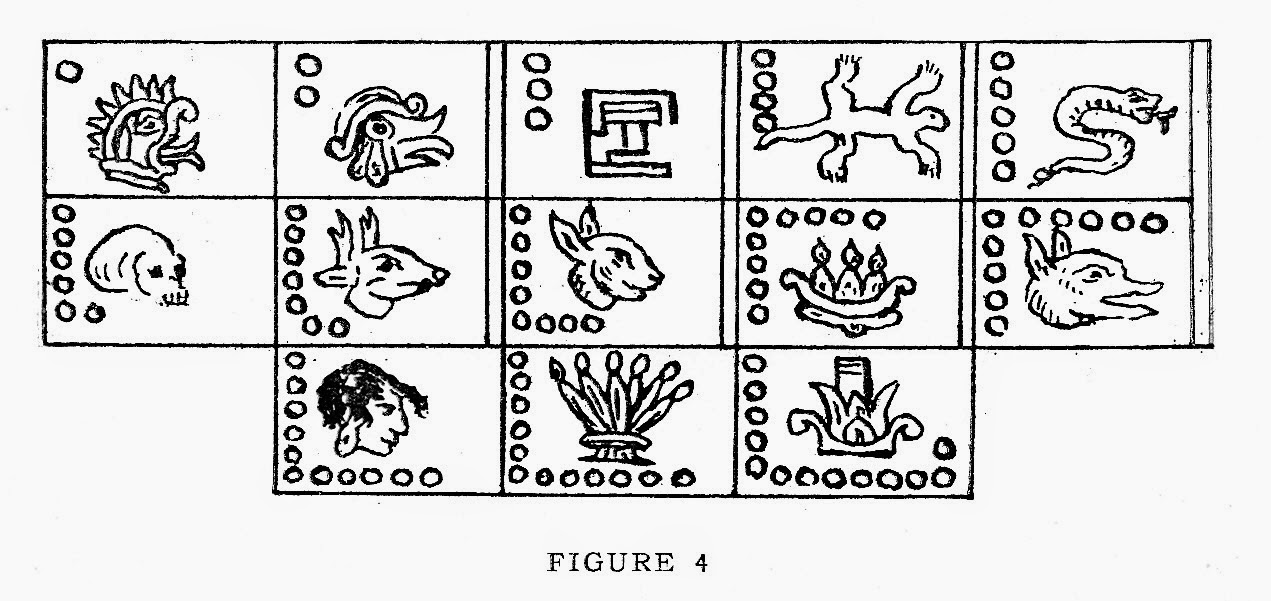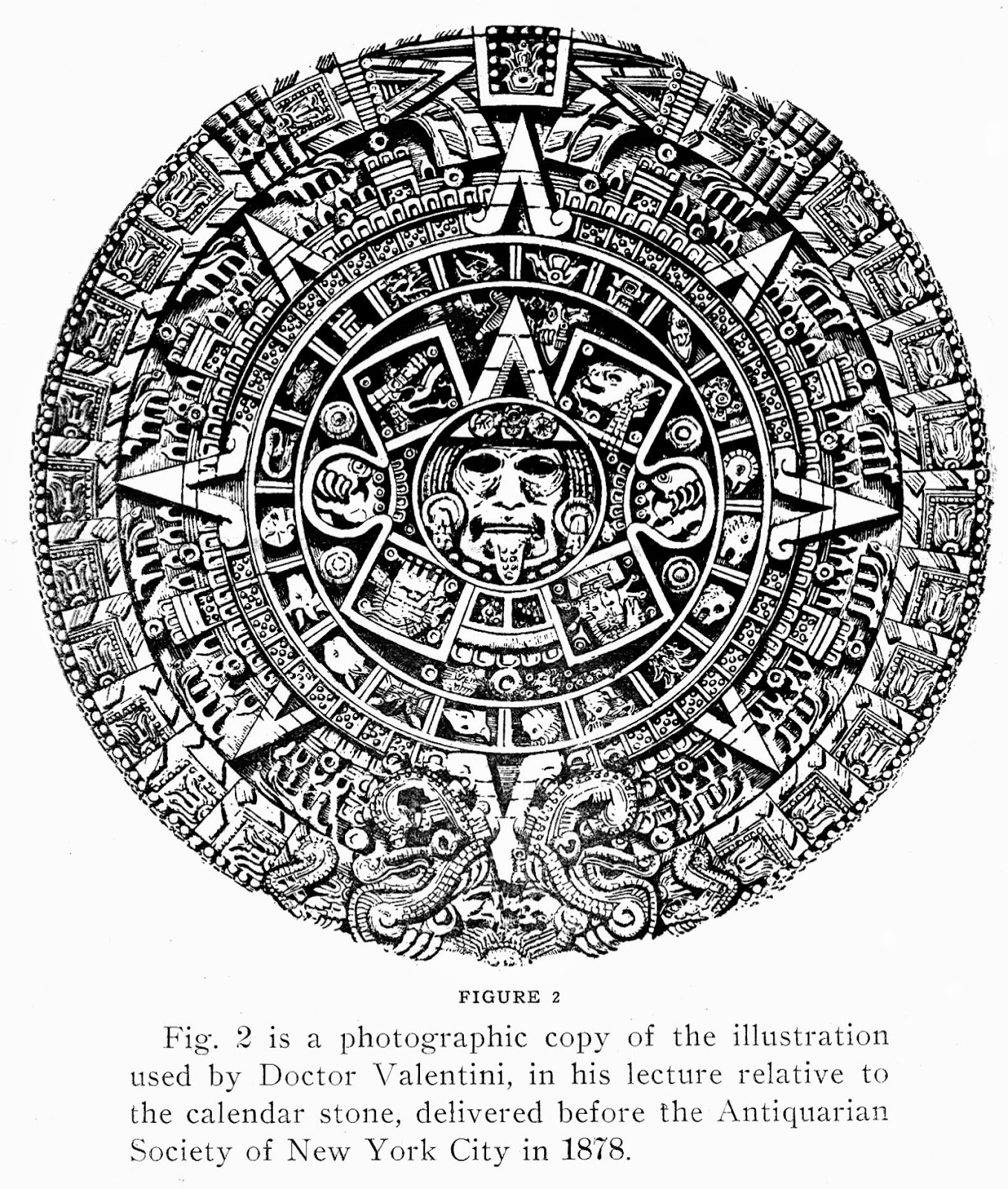The great
“calendar stone,” for such it is accepted, unquestionably, by the most learned
writers of ancient America and, also, those of the present generation, is a
mass of basaltic porphyry weighing, it is estimated, twenty-four tons; its
carved circular surface is eleven feet eight inches in diameter, all, of which,
are devoted, fundamentally, to utilities of an astronomical character.
This “relic of
barbarism” Friar Alonso de Montufar caused to be buried some time between the
years 1551 and 1559, and thus the “scandalizing thing,” practically, ceased to
exist more than two hundred years. While excavating, during the year 1790, in
the Plaza Mayor, the workmen unearthed this valuable historical specimen and
placed it against the wall of the cathedral tower where it remained several
years and, subsequently, it was placed where it is now conspicuously located,
in the Mexican National Museum.
The calendar
stone brings to us some valuable information relative to one particular branch
of the Aztec government; otherwise, it would not come in such an elaborate form
of such enormous weight, as its quarry must have been miles away.
Figure 3 is an
Aztec calendar wheel after Veytia giving the names of the weeks and names of
the days of the
week in their sequence for all time.
 In the
calendar stone we have an authentic work executed by an ancient Aztec artisan,
before any European set foot on the American continent, hence we must consider
it as reliable as possible in what it represents.
In the
calendar stone we have an authentic work executed by an ancient Aztec artisan,
before any European set foot on the American continent, hence we must consider
it as reliable as possible in what it represents.
Fig. 2 is a
photographic copy of the illustration used by Doctor Valentini, in his lecture
relative to the calendar stone, delivered before the Antiquarian Society of New
York City in 1878.
Fig. 3. The
Aztec calendar wheel, after Yeytia, giving the weeks and days of the week for
each season of the year as was generally used, and in its simplest form,
showing the names of the thirteen days of each week in the season, numbered with
dots, according to their use, from one to thirteen, inclusive; also the names
of the seven weeks in each of the four seasons of the year, numbered with dots
from one to seven, inclusive, according to their use.
These twenty
representations occupy the most prominent circle on the calendar stone. (Fig.
2).
The central
picture, (Fig. 3), indicates to us a calendar, as a first consideration,
pertaining to the sun, also, the same, as a second consideration, relating to
the moon. The stars are a third consideration, giving us to understand that
this form of a wheel is to be used once, complete, during each four of the
annual seasons—in other words, go over the wheel four time for one year and
repeat, similarly, for all succeeding years.
 To use this
wheel, start with the first day of the year in the compartment presenting the
picture of a porcupine and one dot, in the daily sequence, this day is also the
first day of the week represented by a tiger and one dot in the weekly
sequence; retain this identified week till all the daily sequence is passed
over from one to thirteen, inclusive; then pass to the second week which is
identified by the eagle and two dots, in the weekly sequence and repeat the
daily sequence of this week as used in the first instance. If something
happened on the sixth day of the third week of the first season of the year, it
happened on the day represented by the skeleton, in the daily sequence with six
dots, in the weekly sequence, the week of the bird with three dots; this would
be two whole weeks plus six days into the third week, making a total of
thirty-two days from the first day or starting day, or from the first day of
the year.
To use this
wheel, start with the first day of the year in the compartment presenting the
picture of a porcupine and one dot, in the daily sequence, this day is also the
first day of the week represented by a tiger and one dot in the weekly
sequence; retain this identified week till all the daily sequence is passed
over from one to thirteen, inclusive; then pass to the second week which is
identified by the eagle and two dots, in the weekly sequence and repeat the
daily sequence of this week as used in the first instance. If something
happened on the sixth day of the third week of the first season of the year, it
happened on the day represented by the skeleton, in the daily sequence with six
dots, in the weekly sequence, the week of the bird with three dots; this would
be two whole weeks plus six days into the third week, making a total of
thirty-two days from the first day or starting day, or from the first day of
the year. When all the
weeks in the season are thus exhausted the count will be ninety-one days, the
total number of days, by the wheel for each season of the year. This process
described pertaining to the first season is repeated for the three remaining
seasons of the year, and distinguished from each other by the following names:
When all the
weeks in the season are thus exhausted the count will be ninety-one days, the
total number of days, by the wheel for each season of the year. This process
described pertaining to the first season is repeated for the three remaining
seasons of the year, and distinguished from each other by the following names:
Acatl, meaning
reed
Tochtli,
meaning rabbit
Calli, meaning
house
Tecpatl,
meaning flint knife
The reader,
naturally, inquires why the two series of dots presented in figure three are
not, likewise, presented on the calendar stone. These dots distinguishing the
movement of time, by the earth’s rotation, being omitted on the calendar stone
is responsible for many authors of Aztec history falling into the serious error
that the Aztec year was composed of eighteen months, each containing twenty-days,
from Humboldt down, with Gama and Prescott included. The reason for the
calendar stone artist leaving dots off the stone was, the sequence of dots, as
presented in figure two, is not the same as the dots in the wheels pertaining
more particularly to the moon, and both these sets need separate wheels to include
their utility, while the names of the seasons, weeks and days of the weeks are,
it will be noted, the same in all cases.
FIGURE 4
As to a
correct presentation of the days and weeks given in figures 4 and 5, after
Duran, these may be verified by the calendar stone as follows.
Table No. 1.
Giving the result of operating the wheel during one season, as explained
relative to its simplest form, Fig. 3.
TABLE NO. 1
Assuming the
reader’s right and left applies to the stone, the first day of the week given
by figure 4 occupies the first compartment on the left of the center at the
top; then proceeding from this compartment to the left, with the circle, to the
thirteenth compartment we have the thirteen days of the week which are repeated
seven times during each season of the year.
 The remaining
compartments in the circle represent the seven weeks of the season as the same
is arranged in figure 5. The first week starts with the first compartment
adjacent to the thirteenth compartment of the daily count as above considered,
and proceeds with the circle, regularly to the seventh week located on the
right of the center at the top, thus closing the whole circle containing a
total of twenty compartments.
The remaining
compartments in the circle represent the seven weeks of the season as the same
is arranged in figure 5. The first week starts with the first compartment
adjacent to the thirteenth compartment of the daily count as above considered,
and proceeds with the circle, regularly to the seventh week located on the
right of the center at the top, thus closing the whole circle containing a
total of twenty compartments.
The part of
the calendar stone we have utilized in this comparison measures one season of
the year, the remaining three seasons of the year are treated like the first
season above described and are distinguished from each other by name.


